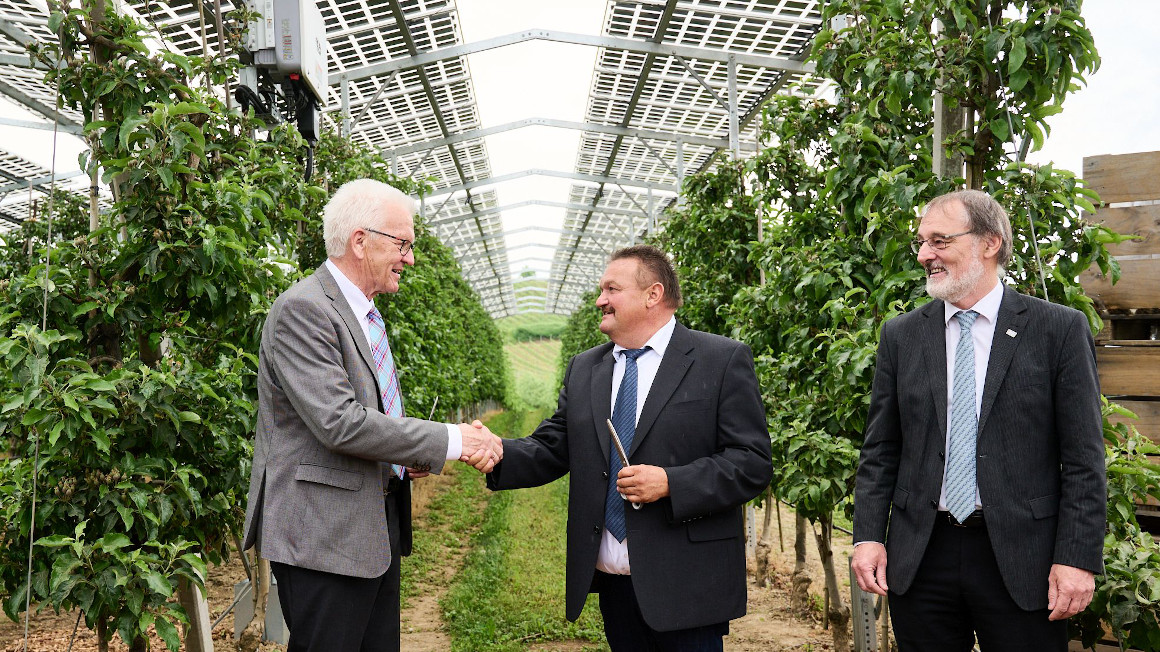With agri-voltaics to sustainable fruit cultivation
The cultivation of pome and soft fruit under photovoltaic systems is being tested in a large-scale trial at five locations in Baden-Wuerttemberg.

Energy crops such as rapeseed and corn are grown on more than one-fifth of the arable land in Germany. This means that they compete with food production for valuable agricultural land. Agri-photovoltaics (Agri-PV) promises a resource-efficient dual use of arable land. The simultaneous use of fields for the cultivation of food crops and for the generation of electricity also opens up new sources of income for farmers. The concept of agri-photovoltaics with a focus on pome and soft fruit is now being tested in the research project „Modellregion Agri-Photovoltaik für Baden-Württemberg“.
Harvest fruit and power at once
Research and demonstration facilities with a total rated output of up to 1,700 kilowatts are to be built at a total of five sites in Bavendorf, Heuchlingen, Karlsruhe, Kressbronn and Oberkirch-Nußbach, and the simultaneous cultivation of apples and berries is to be tested. The project is being funded until 2024 with around 2.5 million euros from the state ministries for the environment, climate and energy and for food, rural areas and consumer protection. The project involves the Kompetenzzentrum Obstbau Bodensee (KOB), the Fraunhofer Institute for Solar Energy Systems ISE and eleven other project partners.
Model region for agri-photovoltaics
"In agri-photovoltaics lies a huge opportunity for agriculture, for sustainability and for energy supply. With the Agri-Photovoltaic Model Region Baden-Wuerttemberg, we want to show how double harvesting works - here, for example, solar energy and apples," said Minister President Kretschmann at the opening of the Agri-PV system on the Bernhard fruit farm in Kressbronn.
On the Kressbronn orchard of farmer Hubert Bernhard, an area of about 0.4 hectares was covered with solar modules with a nominal output of about 250 kilowatts. "We have already been generating solar power on the roofs of our farm buildings since 2010, so we wondered if we could also use the hail nets above our orchards to produce electricity. The result is the first agri-PV system over an existing orchard," Bernhard explains.
Observe plant growth under solar panels
At the plant in Kressbronn, researchers from Fraunhofer ISE and the Kompetenzzentrum Obstbau Bodensee want to study plant growth under the solar panels in detail. "In addition to investigating the effects of varying shading on the growth and ecophysiology of the apples, this also includes research activities on the effects of pesticide use on the PV modules," explains Oliver Hörnle, project manager at Fraunhofer ISE.
Pilot plants have been customized
The pilot plants were customized for all locations and taking into account the different fruit and berry crops in order to investigate the feasibility of different applications and technologies and to explore design variants. In building the Agri-PV plants, the team was already able to draw on experience gained in building a comparable plant for fruit cultivation in Rhineland-Palatinate. "For us, the Agri-PV is another important building block for sustainable fruit production at Lake Constance: protected and thus safe, high-quality apple production with additional solar power production," says Ulrich Mayr, deputy managing director of KOB.
bb


